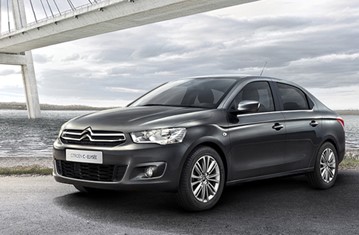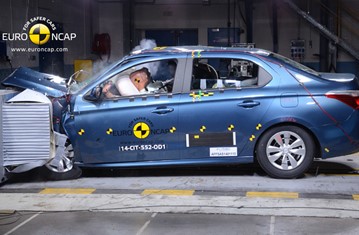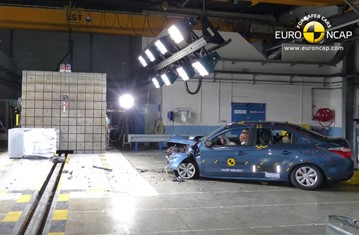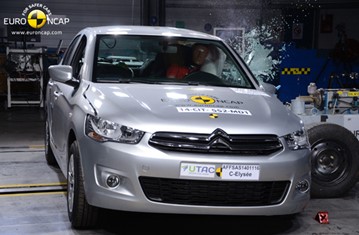Find more information in the General Comments section of the assessment
Find more information in the Rating Validity tab of the assessment
- See More
- See More
- See More
- See More
- Good
- Adequate
- Marginal
- Weak
- Poor
 Passenger
Passenger
 Driver
Driver
 Rear Seat
Rear Seat
 Front Seat
Front Seat
 Car
Car
 Pole
Pole
- Good
- Adequate
- Marginal
- Weak
- Poor


Passenger
outboard
center
Fitted to the vehicle as standard
Not fitted to the test vehicle but available as option
Not Available
-
Infants up to 13 kg
-
Infants and toddlers up to 18 kg
-
Toddlers from 9 to 18 kg
-
Toddlers over 18 kg
Easy
Difficult
Safety critical
Not allowed
| Seat Position | ||||
|---|---|---|---|---|
| Front | 2nd row | |||
| Passenger | Left | center | Right | |
| Maxi Cosi Cabriofix (Belt) | ||||
| Britax Römer King Plus (Belt) | ||||
| Britax Römer Duo Plus (ISOFIX) | ||||
| Britax Römer KidFix (Belt) | ||||
| Maxi Cosi Cabriofix & EasyFix (Belt) | ||||
| Maxi Cosi Cabriofix & EasyFix (ISOFIX) | ||||
| BeSafe iZi Kid X3 ISOfix (ISOFIX) | ||||
| Maxi Cosi Pearl & Familyfix (ISOFIX) | ||||
| Britax Römer KidFix (ISOFIX) | ||||
Easy
Difficult
Safety critical
Not allowed
In the frontal impact, forward movement of the 3 year dummy, sat in a forward-facing restraint, was not excessive but neck loads were quite high. Chest deceleration of the 1½ year dummy was also a little high and protection was rated as fair. In the side impact, both dummies were properly contained by the protective shells of their restraints, minimising the likelihood of head contact with pats of the car's interior. The front passenger airbag can be disabled to allow a rearward-facing child restraint to be used in that seating position. However, the switch, located at the end of the facia, is not labelled clearly enough and the system was not rewarded. All of the restraints which the car is designed to accommodate could be properly installed in the vehicle.
- Good
- Adequate
- Marginal
- Weak
- Poor

Head Impact 13.6 Pts
Pelvis Impact 0.0 Pts
Leg Impact 6.0 Pts
The protection provided by the bumper to pedestrians' legs was good in all areas tested. However, the front edge of the bonnet was poor and scored no points. The protection provided by the bonnet was predominantly good or adequate but was poor at the base of the windscreen and on the stiff windscreen pillars.
- Good
- Adequate
- Marginal
- Weak
- Poor
| System Name | ESP | |
| Performance | ||
| Applies To | Not available | ||
| Warning | Driver Seat | Front Passenger(s) | Rear Passenger(s) |
| Visual | |||
| Audible | |||
|
|||
The C-Elysée has electronic stability control as standard. A seatbelt reminder is standard for the driver's seat but is not available for the passenger seat so the system was not rewarded. A driver-set speed limiter is available as an option. As it is fitted to most cars sold, it was assessed and met Euro NCAP's requirements for systems of this type. The C-Elysée is not available with lane assist or autonomous emergency braking.
- Specifications
- Safety Equipment
- Videos
- Rating Validity
Specifications
Tested Model Citroën C-Elysée 1.2 Séduction, LHD
Body Type - 4 door saloon
Year Of Publication 2014
Kerb Weight 1087kg
VIN From Which Rating Applies - applies to all C-Elysées of the specification tested
Class Small Family Car
Safety Equipment
Note: Other equipment may be available on the vehicle but was not considered in the test year.
Fitted to the vehicle as standard
Fitted to the vehicle as option
Not fitted to the test vehicle but available as option
Not Available
Not Applicable
Videos
Rating Validity




Find more information in the General Comments section of the assessment
 Share
Share









The passenger compartment of the C-Elysée remained stable in the frontal impact. Dummy readings indicated good protection of the knees and femurs of the driver and passenger in the test. However, structures in the dashboard posed a risk of injury to occupants of different sizes and to those sat in different positions and the score was downgraded. Readings of chest compression in the driver dummy indicated a marginal level of protection for this body region. In the side impact, protection of all body regions was good except for the abdomen, protection of which was adequate. However, in the more severe side pole impact, dummy readings of chest compression indicated a weak level of protection for this body region. The score was penalised because some forces were transmitted through parts of the dummy structure which would further load the chest of a human, and protection of the chest area was rated as poor. Protection against whiplash injury in a rear-end collision was good for the front seats but poor for the rear seats.